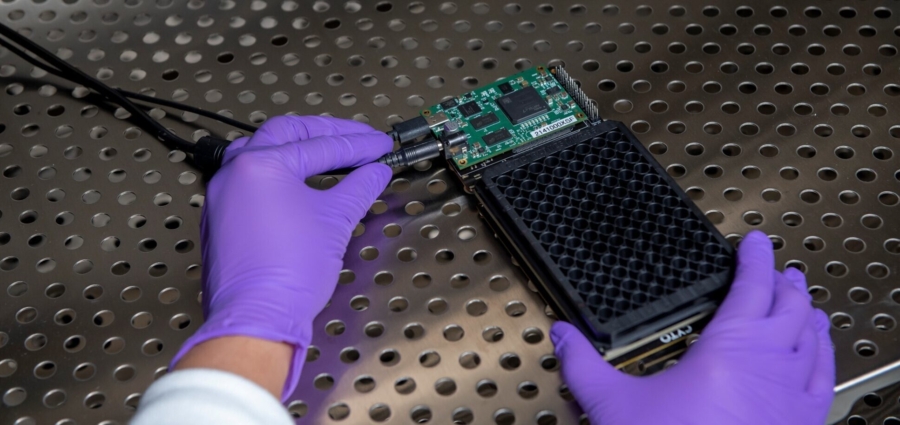Harvard engineers use data science to accelerate drug discovery

Abbott and Wu’s invention, a semiconductor-based technology platform that can both measure and manipulate cells. Photo by CytoTronics
The convergence of semiconductor technology and drug discovery holds great promise in the pursuit for new medications and therapies. But drug discovery is notorious for being lengthy, inefficient, costly, and difficult. A startup spun-out of Harvard labs is working to change that.
CytoTronics, Inc., a pioneer of semiconductor-based platforms for cell biology research, developed a high-throughput semiconductor platform that will offer a dynamic, real-time assessment of live cells’ characteristics, such as epithelial barrier properties, which are crucial for understanding diseases like cancer, fibrosis, inflammation, and cystic diseases.
CytoTronics’ semiconductor platform captures an order of magnitude more information per biological sample than previous commercial techniques, at a scale of throughput useful for drug discovery screening. Nature Communications recently published the companies finding in a research paper titled “A Semiconductor 96-Microplate Platform for Electrical-Imaging Based High-Throughput Phenotypic Screening.” The developments made by CytoTronics have the potential to revolutionize and accelerate the way pharmaceutical research is conducted.
The research paper, authored by CytoTronics’ co-founders Jeffrey Abbott, Vince (Wenxuan) Wu, and Duane Sword, introduces a semiconductor-based 96 well-microplate designed for electrical imaging-based phenotypic screening. Having more front-end screening information allows scientists to better understand how prospective drugs are affecting live-cell biology, enabling faster iterations on drug design, or finding dead-ends faster. Additionally, this platform is adaptable to a wide range of cell types and applications.
Founded in 2020, CytoTronics introduces a semiconductor-based platform that boasts 4,096 electrodes per well, versus the standard 2 electrodes per well, allowing researchers to capture large amounts of data. Moreover, miniaturized data interfaces enable parallel plate operation across 768 total wells within standard cell culture incubators, resulting in unmatched throughput. The original semiconductor integrated circuit was designed in the labs of Donhee Ham, the Gordon McKay professor of electrical engineering and applied physics at the John A. Paulson School of Engineering and Applied Sciences, and Hongkun Park, the Mark Hyman Jr. professor of chemistry and professor of physics at the Faculty of Arts and Sciences at Harvard, where Abbott and Wu were postdocs. Co-founders Abbott and Wu worked with Harvard’s Office of Technology Development (OTD) to protect the platform technology’s innovations in the paper. OTD introduced Abbott and Wu to Sword, who is now the company co-founder and CBO, and connected the trio with software engineers that run the company’s data analysis and visualization efforts, ultimately launching CytoTronics, Inc.
“Our semiconductor 96-microplate platform represents a significant advancement in the world of high-throughput phenotypic screening,” stated Jeffrey Abbott, co-founder and CEO of CytoTronics. “Our technology allows you to see signals from thousands of single cells. This opens the door for assessing heterogeneity of cell populations and improves sensitivity as you get signal even with just a few cells. For example, in personalized medicine applications using extracted human tissue, being able to assess cellular function with less starting material is a huge win for the industry.”
CytoTronics is commercializing the published technology and bringing it to market in the form of instruments and microplates. The first of its products will launch next year.





